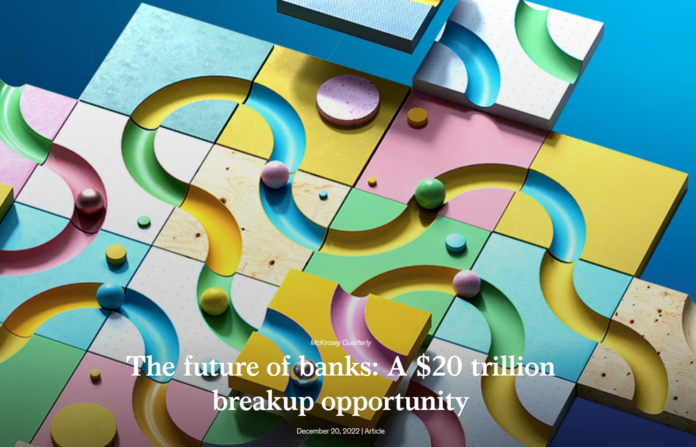The banking sector is at a turning point. Key measures for banks are at a historical low point. The sector’s price-to-book value has fallen to less than one-third the value of other industries. That gap is less the result of current profitability and more about uncertain profit growth in the future. While banks have pushed for great improvements recently, margins are shrinking—down more than 25 percent in the past 15 years and expected to fall to 30 percent, another 20 percent decrease, in the next decade.
Regulation and increasing intersectional competition are still worries, but the bigger threat is a global trend: new challenges—often from different industries and often benefiting from the kind of cross-industry platforms behind the recent success of companies such as Amazon, Google, Microsoft, PayPal, and Spotify—with a vastly superior economic model. The market believes that banks are headed in the wrong direction, without a future-proof strategy.
We believe that the skeptics are right about today—and wrong about tomorrow. Banking is facing a future marked by fundamental restructuring. But we also believe that banks that successfully manage this transition will become bigger and more profitable and grow faster while leading to a value creation opportunity of up to $20 trillion.1
Competitive arenas and business models are emerging in banking
The era when all financial services were dominated by monolithic banking entities is over. What, then, will arise to take its place? We believe that the future of banking will be contested by banks and nonbanks in five cross-industry competitive arenas: everyday banking, investment advisory, complex financing, mass wholesale intermediation, and banking as a service (BaaS).
The future of banking will be contested in five cross-industry competitive arenas. In the next decade, revenues for all these arenas could grow by as much as three to 30 times.
While these arenas encompass the products and services provided by banks today, they will be redefined and reinvented by different customer needs. This new competitive landscape has transformative potential. In the next decade, revenues for all these arenas could grow dramatically, by as much as three to 30 times.
In each of the five arenas, we see the potential for at least two platform business models. These ten platforms aren’t theoretical models. They are trends that we already see in progress among organizations that are winning better valuations in the capital markets.
An inside look at the biggest arena: Everyday banking
The new arenas will require banks or nonbanks to ramp up their presence on new platforms, create touchpoints with customers, and mine and capture data in new ways. To understand how these concepts will play out, let’s examine the biggest arena: everyday banking.
Imagine that a forward-looking bank or a new fintech competitor offers an app we will call “MyLifeAssistant.” MyLifeAssistant will take many existing technologies that customers find on their phones—and many still to be developed—and fold them into a single offering that addresses a whole range of users’ daily needs. For instance, it might send an alert that today is the birthday of a friend, along with a gift recommendation. Users could order the gift through MyLifeAssistant and arrange for same-day shipping, or they could shop for alternatives.
Analysis: The way people manage their money is rapidly changing and if banks do not begin to innovate they will fall behind. This article explains how people are finally starting to push back on traditional banking and challenge the financial processes that have been around for centuries because of external business models coming into play. New and successful business models, such as business gateway providers, B2B advisory boutiques, real-estate-journey orchestrators, and more prove that the customer wants managing their money to be more personable, more efficient, and more understandable. There are many ways banks can approach this goal, through investment advisory, complex financing, mass wholesale intermediation, and so much more, but it is up the bank to decide which will make the most sense for their culture and their ever-growing customer. As a researcher and designer, this article provides a dense amount of current business solutions to pick a part and interpret on behalf of Huntington and their customer. I will need to look into these models from a very skeptical/critical lens that will inspire a path to ethical solutions.
Citation:
Czímer, B., Dietz, M., László, V., & Sengupta, J. (2022, December 20). The Future of Banks: A $20 trillion breakup opportunity. McKinsey & Company. https://www.mckinsey.com/industries/financial-services/our-insights/the-future-of-banks-a-20-trillion-dollar-breakup-opportunity




